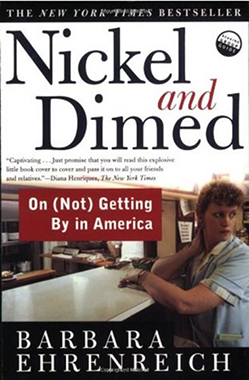 Nickel and Dimed: On (Not) Getting By In America
Nickel and Dimed: On (Not) Getting By In America
By Barbara Ehrenreich
Ehrenreich in this book calls attention to the millions of Americans working full-time, year-round, for poverty-level wages. In her research, Ehrenreich took minimum-wage jobs in 1998 in three cities to see if survival was possible. Her first-hand investigation and discouraging findings have caught the attention of the media and finally brought national attention to the plight of the working poor.
From http://www.barbaraehrenreich.com/nickelanddimed.htm
The New York Times bestseller, and one of the most talked about books of the year, Nickel and Dimed has already become a classic of undercover reportage.
Millions of Americans work for poverty-level wages, and one day Barbara Ehrenreich decided to join them. She was inspired in part by the rhetoric surrounding welfare reform, which promised that any job equals a better life. But how can anyone survive, let alone prosper, on $6 to $7 an hour?
To find out, Ehrenreich moved from Florida to Maine to Minnesota, taking the cheapest lodgings available and accepting work as a waitress, hotel maid, house cleaner, nursing-home aide, and Wal-Mart salesperson. She soon discovered that even the “lowliest” occupations require exhausting mental and physical efforts. And one job is not enough; you need at least two if you intend to live indoors.
Nickel and Dimed reveals low-wage America in all its tenacity, anxiety, and surprising generosity — a land of Big Boxes, fast food, and a thousand desperate strategies for survival. Instantly acclaimed for its insight, humor, and passion, this book is changing the way America perceives its working poor.

